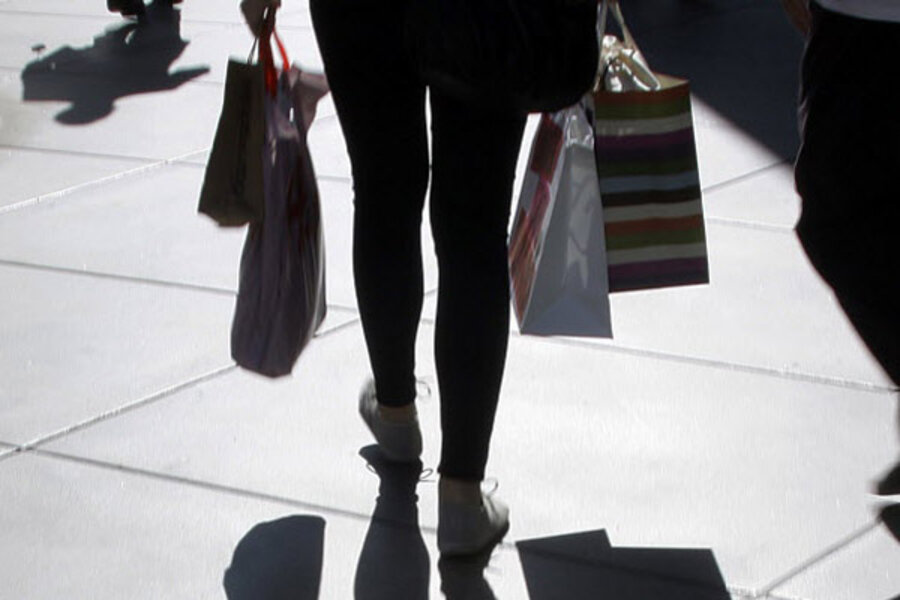US economy grew at 2.5%. Will that quiet talk of a double dip?
Loading...
| New York
Maybe there won't be a double-dip recession in the US.
That's one possible takeaway of news that America's economy grew in the third quarter at an annual rate of 2.5 percent – a meaningful improvement over the lackluster first half of the year that had raised concerns about the prospect of back-to-back recessions.
The better growth rate was spurred in large part by somewhat stronger consumer spending, mostly for big-ticket items such as cars and light trucks, according to data from the US Commerce Department. However, the modest growth in gross domestic product (GDP) won’t do much to lower the jobless rate, which has been stuck at about 9 percent.
“You have to be growing at 3 percent or better to see any meaningful improvement in the employment situation,” says Richard DeKaser, an economist at the Parthenon Group, a strategic consulting firm in Boston.
The report on the economy’s performance comes as European leaders agreed on a plan to start to resolve the European debt crisis. The US stock market surged early Thursday, with the Dow Jones Industrial Average gaining more than 266 points – rising above 12000 for the first time since August.
"The market has priced in a Lehman Brothers-type scenario,” says Mr. DeKaser, referring to the trigger of the financial crash of 2008. “This agreement removes that fear.”
The settlement in Europe could indeed help the US economy, says John Silvia, chief economist at Wells Fargo Securities in Charlotte, N.C.
“The European agreement does remove a certain amount of uncertainty and especially the risk of a big recession in Europe,” says Mr. Silvia. “A big recession in Europe ran the risk of putting the US back in a recessionary mode.”
A key reason the economy bounced back in the third quarter was a pick-up in durable goods orders, which rose 4.1 percent (compared with a drop of 5.3 percent in the second quarter), according to the Commerce report.
Some of this was the result of a “snap back” in vehicle purchases, says Mr. DeKaser, noting that earlier this year some Japanese models were unavailable after the earthquake and tsunami in Japan. “As the inventories were replenished, consumers were able to get autos [that had been] in short supply,” he says.
Silvia suggests that improvement in autos and the consumer sector may mean consumers are a little more optimistic than they are saying in various consumer surveys. Consumer spending was up 2.4 percent in the third quarter over the second quarter. This could mean that holiday retail sales will somewhat better than Wall Street's current ho-hum sales outlook.
Another big boost for the economy came from businesses, which invested heavily in new plant and equipment, especially computers. Compared with the second quarter, business fixed investment rose 16.3 percent, which is a “huge plus for the economy,” writes Nigel Gault, chief economist for IHS Global Insight in Lexington, Mass., in an analysis.
Business spending may increase even more during the fourth quarter, suggests DeKaser, because companies will want to take advantage of a number of tax credits set to expire at the end of the year.
The GDP report also shows that businesses drew down their inventories. The lack of inventory-building suggests that production may need to accelerate to keep pace with sales, says Mr. Gault. As a result, he has increased his estimate for fourth-quarter growth from a 1 percent annual pace to a 2 percent annual pace.
DeKaser, who expects GDP to grow at a 2.3 percent annual pace in the fourth quarter, says the US economy will be restrained by the soft labor market and the slow recovery of “wealth,” from both the stock market and housing.
The economy is also being constrained by layoffs from state and local governments. In the third quarter, state and local expenditures fell 1.3 percent. “Historically, this sector has added 0.25 percent to economic growth; this year it will subtract from growth by that much,” writes Sung Won Sohn, an economist and professor at California State University, Channel Islands, in an analysis.





